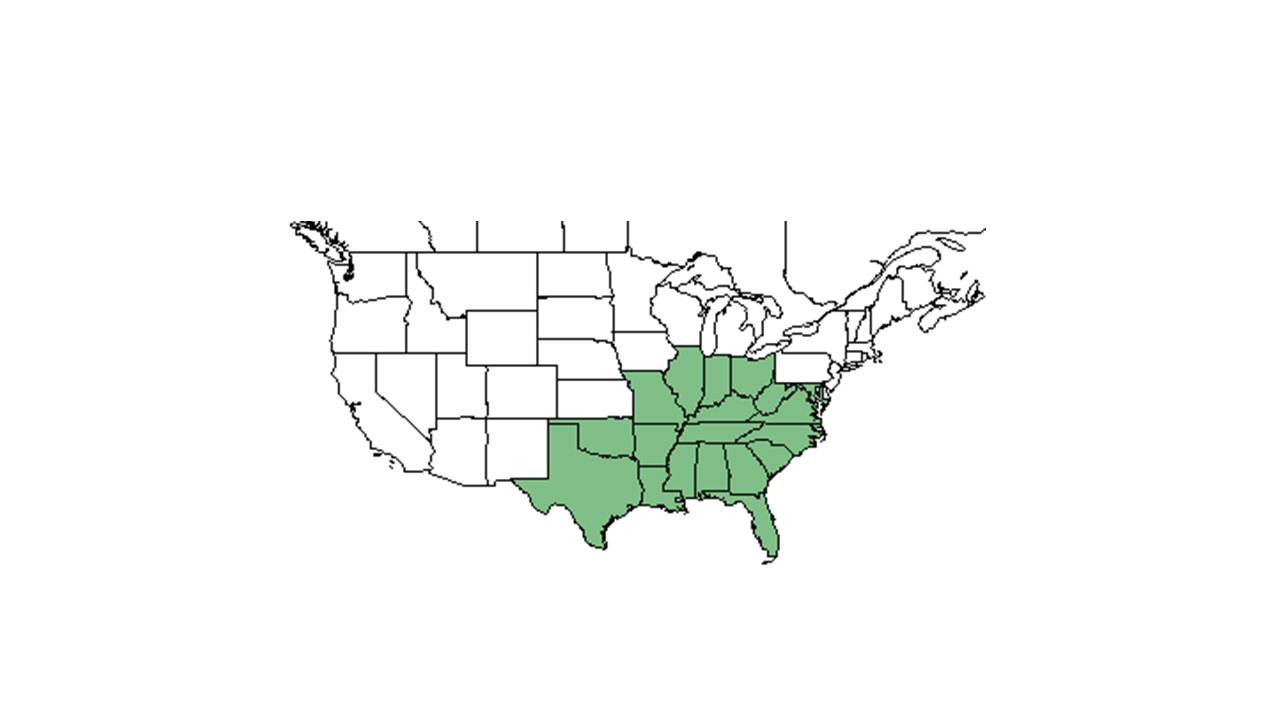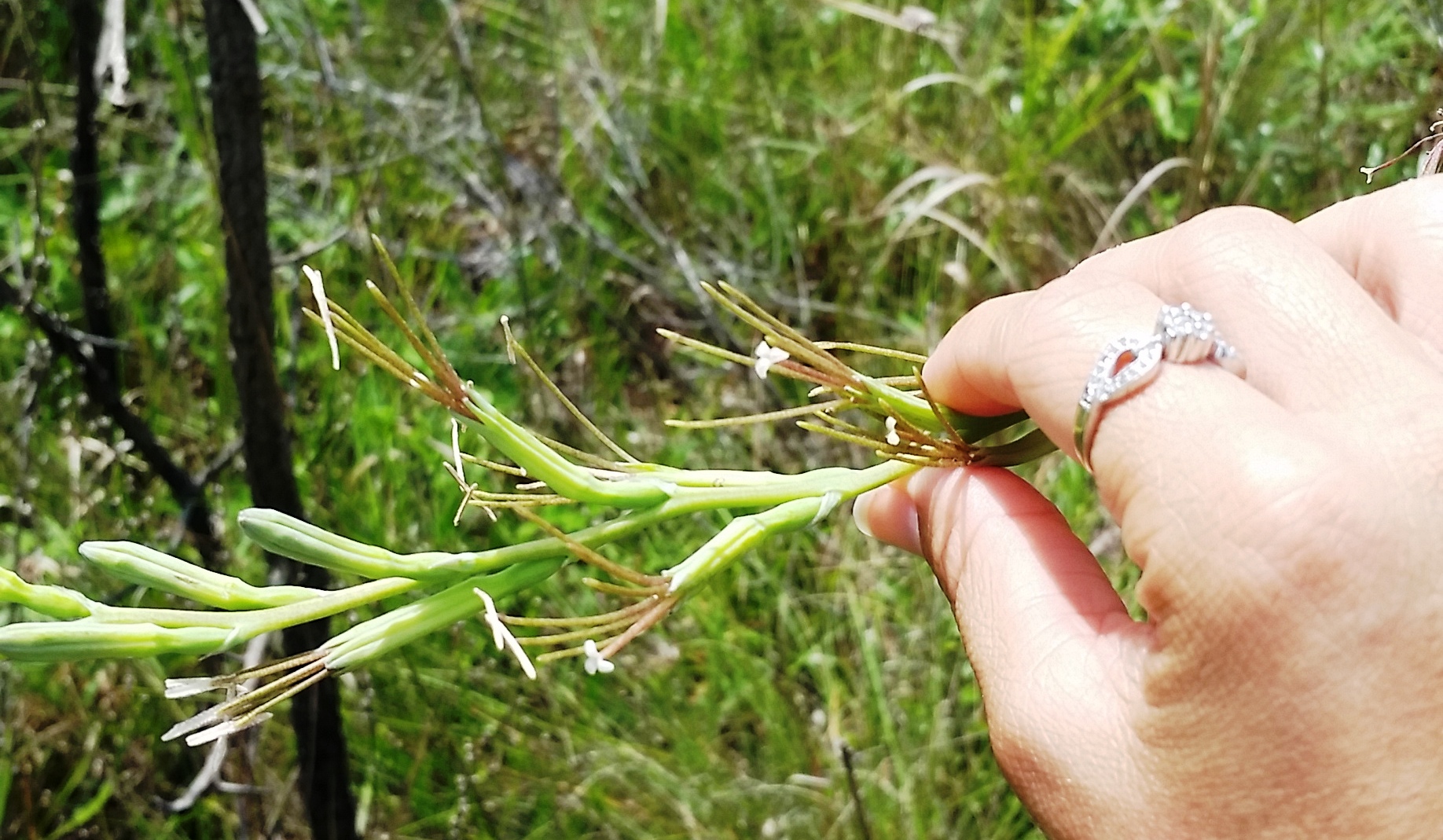Difference between revisions of "Manfreda virginica"
Emmazeitler (talk | contribs) |
|||
| Line 18: | Line 18: | ||
}} | }} | ||
| − | Common names: False aloe; Rattlesnake-master | + | Common names: False aloe; Rattlesnake-master<ref name="weakley">Weakley, A.S. 2015. Flora of the southern and mid-atlantic states. Working Draft of 21 May 2015. University of North Carolina at Chapel Hill, Chapel Hill, North Carolina.</ref> |
==Taxonomic notes== | ==Taxonomic notes== | ||
| − | Synonyms: ''Agave virginica'' Linnaeus; ''Manfreda tigrina'' (Engelmann) Small; ''Polianthes virginica'' (Linnaeus) Shinners | + | Synonyms: ''Agave virginica'' Linnaeus; ''Manfreda tigrina'' (Engelmann) Small; ''Polianthes virginica'' (Linnaeus) Shinners.<ref name="weakley">Weakley, A.S. 2015. Flora of the southern and mid-atlantic states. Working Draft of 21 May 2015. University of North Carolina at Chapel Hill, Chapel Hill, North Carolina.</ref> |
| + | |||
| + | Varieties: none.<ref name="weakley">Weakley, A.S. 2015. Flora of the southern and mid-atlantic states. Working Draft of 21 May 2015. University of North Carolina at Chapel Hill, Chapel Hill, North Carolina.</ref> | ||
==Description== | ==Description== | ||
<!-- Basic life history facts such as annual/perrenial, monoecious/dioecious, root morphology, seed type, etc. --> | <!-- Basic life history facts such as annual/perrenial, monoecious/dioecious, root morphology, seed type, etc. --> | ||
| Line 26: | Line 28: | ||
==Distribution== | ==Distribution== | ||
| + | ''M. virginica'' ranges from eastern South Carolina, central North Carolina, southwest Virginia, western West Virginia, southern Ohio, southern Indiana, southern Illinois, and Missouri, south to central peninsular Florida and Texas.<ref name="weakley">Weakley, A.S. 2015. Flora of the southern and mid-atlantic states. Working Draft of 21 May 2015. University of North Carolina at Chapel Hill, Chapel Hill, North Carolina.</ref> | ||
==Ecology== | ==Ecology== | ||
===Habitat=== <!--Natural communities, human disturbed habitats, topography, hydrology, soils, light, fire regime requirements for removal of competition, etc.--> | ===Habitat=== <!--Natural communities, human disturbed habitats, topography, hydrology, soils, light, fire regime requirements for removal of competition, etc.--> | ||
| − | This species | + | This species grows in well-drained or poorly-drained slopes of longleaf pine forests, savannas, mesic pine-hardwood forest remnants, granite flatrocks, diabase glades, limestone and dolomite barrens and glades, xeric woodlands over mafic or calcareous rocks, sandhill woodlands, and dry roadbanks.<ref name="FSU Herbarium">Florida State University Robert K. Godfrey Herbarium database. URL: [http://herbarium.bio.fsu.edu http://herbarium.bio.fsu.edu]. Last accessed: June 2014. Collectors: Robert K. Godfrey, R. Komarek, Loran C. Anderson, and Annie Schmidt. States and Counties: Florida: Leon and Washington. Georgia: Grady and Thomas.</ref><ref name="weakley">Weakley, A.S. 2015. Flora of the southern and mid-atlantic states. Working Draft of 21 May 2015. University of North Carolina at Chapel Hill, Chapel Hill, North Carolina.</ref> It prefers sandy loam habitats and upland Coastal Plain soils that have little slope and low fertility. <ref name="Miller et al 1999">Miller, J. H., R. S. Boyd, et al. (1999). "Floristic diversity, stand structure, and composition 11 years after herbicide site preparation." Canadian Journal of Forest Research 29: 1073-1083.</ref> Additionally, it thrives in semi-shaded areas to open areas. Associated species include longleaf pine, wiregrass, and hardwoods.<ref name="FSU Herbarium"/> |
===Phenology=== <!--Timing off flowering, fruiting, seed dispersal, and environmental triggers. Cite PanFlora website if appropriate: http://www.gilnelson.com/PanFlora/ --> | ===Phenology=== <!--Timing off flowering, fruiting, seed dispersal, and environmental triggers. Cite PanFlora website if appropriate: http://www.gilnelson.com/PanFlora/ --> | ||
| − | ''M. virginica'' | + | ''M. virginica'' flowers from late May through August and fruits from August through October.<ref name="weakley">Weakley, A.S. 2015. Flora of the southern and mid-atlantic states. Working Draft of 21 May 2015. University of North Carolina at Chapel Hill, Chapel Hill, North Carolina.</ref> |
<!--===Seed dispersal===--> | <!--===Seed dispersal===--> | ||
<!--===Seed bank and germination===--> | <!--===Seed bank and germination===--> | ||
===Fire ecology=== <!--Fire tolerance, fire dependence, adaptive fire responses--> | ===Fire ecology=== <!--Fire tolerance, fire dependence, adaptive fire responses--> | ||
| − | This species is found in annually burned areas. <ref name="FSU Herbarium"/> | + | This species is found in annually burned areas.<ref name="FSU Herbarium"/> |
===Pollination=== | ===Pollination=== | ||
| − | ''M. virginica'' is pollinated both diurnally and nocturnally, with observations suggesting that bumblebees are the predominant floral visitors. <ref name="Groman and Pellmyr 1999">Groman, J. D. and O. Pellmyr (1999). "The pollination biology of Manfreda virginica (Agavaceae): relative contribution of diurnal and nocturnal visitors." Oikos 87: 373-381.</ref> ''Bombus pennsylvanicus'' and ''Hemaris diffinis'' are critical diurnal pollinators; however, diurnally pollinated plants were observed to produce significantly lower seed set than nocturnally and open pollinated plants. <ref name="Groman and Pellmyr 1999"/> Hence nocturnal visitors contribute more to ''M. virginica'' reproduction despite frequent diurnal visits. <ref name="Groman and Pellmyr 1999"/> | + | ''M. virginica'' is pollinated both diurnally and nocturnally, with observations suggesting that bumblebees are the predominant floral visitors.<ref name="Groman and Pellmyr 1999">Groman, J. D. and O. Pellmyr (1999). "The pollination biology of Manfreda virginica (Agavaceae): relative contribution of diurnal and nocturnal visitors." Oikos 87: 373-381.</ref> ''Bombus pennsylvanicus'' and ''Hemaris diffinis'' are critical diurnal pollinators; however, diurnally pollinated plants were observed to produce significantly lower seed set than nocturnally and open-pollinated plants.<ref name="Groman and Pellmyr 1999"/> Hence nocturnal visitors contribute more to ''M. virginica'' reproduction despite frequent diurnal visits.<ref name="Groman and Pellmyr 1999"/> |
<!--===Use by animals===--> <!--Herbivory, granivory, insect hosting, etc.--> | <!--===Use by animals===--> <!--Herbivory, granivory, insect hosting, etc.--> | ||
<!--===Diseases and parasites===--> | <!--===Diseases and parasites===--> | ||
Revision as of 10:41, 28 September 2020
| Manfreda virginica | |
|---|---|

| |
| Photo taken by Gil Nelson | |
| Scientific classification | |
| Kingdom: | Plantae |
| Division: | Magnoliophyta - Flowering plants |
| Class: | Liliopsida – Monocotyledons |
| Order: | Liliales |
| Family: | Agavaceae |
| Genus: | Manfreda |
| Species: | M. virginica |
| Binomial name | |
| Manfreda virginica (L.) Salisb. ex Rose | |

| |
| Natural range of Manfreda virginica from USDA NRCS Plants Database. | |
Common names: False aloe; Rattlesnake-master[1]
Contents
Taxonomic notes
Synonyms: Agave virginica Linnaeus; Manfreda tigrina (Engelmann) Small; Polianthes virginica (Linnaeus) Shinners.[1]
Varieties: none.[1]
Description
A description of Manfreda virginica is provided in The Flora of North America.
Distribution
M. virginica ranges from eastern South Carolina, central North Carolina, southwest Virginia, western West Virginia, southern Ohio, southern Indiana, southern Illinois, and Missouri, south to central peninsular Florida and Texas.[1]
Ecology
Habitat
This species grows in well-drained or poorly-drained slopes of longleaf pine forests, savannas, mesic pine-hardwood forest remnants, granite flatrocks, diabase glades, limestone and dolomite barrens and glades, xeric woodlands over mafic or calcareous rocks, sandhill woodlands, and dry roadbanks.[2][1] It prefers sandy loam habitats and upland Coastal Plain soils that have little slope and low fertility. [3] Additionally, it thrives in semi-shaded areas to open areas. Associated species include longleaf pine, wiregrass, and hardwoods.[2]
Phenology
M. virginica flowers from late May through August and fruits from August through October.[1]
Fire ecology
This species is found in annually burned areas.[2]
Pollination
M. virginica is pollinated both diurnally and nocturnally, with observations suggesting that bumblebees are the predominant floral visitors.[4] Bombus pennsylvanicus and Hemaris diffinis are critical diurnal pollinators; however, diurnally pollinated plants were observed to produce significantly lower seed set than nocturnally and open-pollinated plants.[4] Hence nocturnal visitors contribute more to M. virginica reproduction despite frequent diurnal visits.[4]
Conservation and management
Cultivation and restoration
Photo Gallery
References and notes
- ↑ 1.0 1.1 1.2 1.3 1.4 1.5 Weakley, A.S. 2015. Flora of the southern and mid-atlantic states. Working Draft of 21 May 2015. University of North Carolina at Chapel Hill, Chapel Hill, North Carolina.
- ↑ 2.0 2.1 2.2 Florida State University Robert K. Godfrey Herbarium database. URL: http://herbarium.bio.fsu.edu. Last accessed: June 2014. Collectors: Robert K. Godfrey, R. Komarek, Loran C. Anderson, and Annie Schmidt. States and Counties: Florida: Leon and Washington. Georgia: Grady and Thomas.
- ↑ Miller, J. H., R. S. Boyd, et al. (1999). "Floristic diversity, stand structure, and composition 11 years after herbicide site preparation." Canadian Journal of Forest Research 29: 1073-1083.
- ↑ 4.0 4.1 4.2 Groman, J. D. and O. Pellmyr (1999). "The pollination biology of Manfreda virginica (Agavaceae): relative contribution of diurnal and nocturnal visitors." Oikos 87: 373-381.
